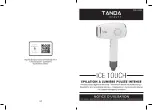
www.frsky-rc.com
FrSky Electronic Co., Ltd
Tel: (86) 0510-85187718 Fax: (86) 0510-85187728 E-mail: [email protected] Technical Support:
11
PAGE7:
SERVOS
The SERVOS page is the interface between the
setup "logic" and the real world with servos,
linkages and control surfaces. Up to now, we have
set up what we want our different controls to do,
now is the time to adapt that to the mechanical
characteristics of the model.
For each channel, we can define:
A name, that will be shown on the mixer screen
when the cursor is on a line belonging to that
channel, on the channel monitor and on the
failsafe settings page.
An offset or subtrim.
Low and high limits. These are "hard" limits, i.e.
they will never be overridden, so as long as
they are set so that your servo never forces, it
really never will. They also serve as gain or
"end point settings", so reducing limit will
reduce throw rather than induce clipping.
Servo reverse.
Center adjustment. This is similar to subtrim,
with the difference that an adjustement done
here will shift the entire servo throw
(including limits), and won't be visible on the
channel monitor.
Subtrim behavior: When set to default,
adjusting subtrim will only shift the center of
the servo throw. Given a -100% to +100%
order from the mixer, the servo will still move
exactly between the lower and upper limits,
without clipping or dead band. This introduces
a different stick to servo movement relation for
both sides of the stick. Depending on the
situation it can be either convenient or
probematic, so the = setting changes subtrim
effect to rather shift the servo throw
"symmetrically". A full throw order from the
mixer can now be clipped by the limit that is on
the same side as the subtrim, while on the
other side the servo will not reach the limit
anymore. That way on both sides of the stick a
given stick movement always results in the
same servo movement. Typically using the
default mode allows for faster setup of servos
that are driven by a single control input, while
= is required to keep correct response of
control surfaces using differential and/or
mixing several inputs together. The = mode
typically requires reducing D/R so that a
margin is left between full "control" throw and
the defined limits.
The last line after CH32 is the "Trims to
Offsets" function. It is used to take the trims of
the currently selected flight mode, transfer
their content to the subtrims, reset them, and
adjust all other flight modes' trims. If you're
close to running out of trim, instead of having
to adjust every value one after the other, all it
takes is to long press ENTER on this line and
everything is done magically. Beware that you
should still check if it would not be wiser to
correct the problem mechanically, especially
with large values, as depending on the subtrim
behavior setting it might lead to either
unsufficient and assymetric throws, or
clipping/dead band.
PAGE8:
CURVES
Custom curves can be used either in input
formatting or mixers. There are 16 of them
available, and they can be of several types (3, 5, 9,
17pt, both with fixed or user-definable x
coordinates). 3pt would be a 3-point curve with
fixed x, 9pt' is a 9-point curve with user-defined x
coordinates. These curves are available in addition
to the "built-in" curves:
x>0, x<0: If input is positive resp. negative,
return input, otherwise 0.
|x|: Return the absolute value of the input.










































